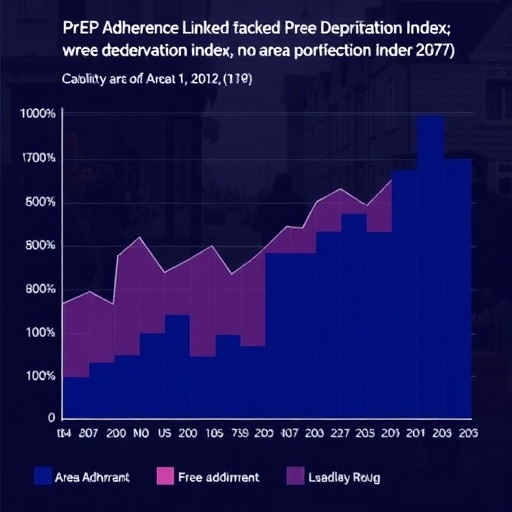
In recent years, the fight against HIV has seen significant advancements, particularly with the introduction of pre-exposure prophylaxis (PrEP). PrEP is a method of preventing HIV infection in individuals who are at high risk. It consists of taking antiretroviral medication on a daily basis to significantly reduce the likelihood of contracting the virus. However, despite its proven effectiveness, adherence to PrEP varies across different populations and geographical areas. A recent study conducted by researchers, including Shu, Momtazi-Mar, and Kovach, sheds light on this critical issue, focusing specifically on how adherence to PrEP is influenced by the area deprivation index (ADI).
The area deprivation index is a composite measure that reflects the socio-economic conditions of a particular area, taking into account factors such as income, education, and employment levels. The study’s findings indicate a significant correlation between higher ADI scores—indicative of higher deprivation levels—and lower rates of PrEP adherence. This suggests that individuals residing in disadvantaged areas may face additional barriers that affect their ability to consistently use PrEP as prescribed.
Understanding the dynamics of PrEP adherence through the lens of socio-economic factors is essential for health professionals and policymakers. The implications of the study highlight the need for targeted interventions that address the unique challenges faced by communities with higher deprivation levels. For instance, individuals in these areas may have limited access to healthcare services, including necessary follow-up appointments and educational resources about PrEP. Additionally, financial constraints may hinder access to the medication itself, further exacerbating the problem of adherence.
Furthermore, social stigma surrounding HIV and the use of PrEP can also play a significant role. In areas with high deprivation indices, societal attitudes may deter individuals from seeking out and maintaining their PrEP regimen. The combination of socio-economic challenges and stigma creates a complex landscape that requires thoughtful navigation. Health educators and community leaders must overlap their efforts to increase awareness and reduce stigma associated with HIV prevention strategies, including PrEP.
To combat these issues, community outreach programs could serve as a viable approach to enhance adherence. By providing localized educational workshops that address not only the importance of PrEP but also the realities of living in a deprived area, we can empower individuals. Tailored messaging that resonates with community sentiments and dismantles misinformation can be instrumental. These efforts can create an environment conducive to healthcare discussions, thus fostering a supportive community around HIV prevention.
Moreover, peer support networks can be beneficial in promoting PrEP adherence. Connecting individuals with others who have successfully navigated the challenges of using PrEP can provide the encouragement and motivation needed to remain consistent. These networks can enhance social connections that might be lacking in more deprived areas, reducing feelings of isolation that can arise from a stigma-laden experience. The growth of such networks may not only contribute to improved adherence rates but also help in reinforcing a positive perception of PrEP and its role in HIV prevention.
The study also points to the importance of healthcare provider training in understanding the socio-economic factors impacting PrEP adherence. Health professionals must be equipped to recognize these barriers and work collaboratively with patients to create shared plans for PrEP usage. Employing a patient-centered approach that respects the unique circumstances of each individual could lead to improved communication and ultimately better health outcomes.
In addition to educational outreach and support networks, policy change is necessary to improve access to PrEP in underserved communities. This may include ensuring that PrEP is covered by insurance plans without exorbitant out-of-pocket costs, as financial limitations are often a significant barrier. Furthermore, enhancing accessibility to healthcare services, including routine testing and monitoring, is vital in facilitating continuity of care for those using PrEP.
Equity in healthcare provision necessitates concerted efforts to address the disparities reflected by the area deprivation index. Research such as that conducted by Shu and colleagues serves as a crucial reminder of the intersection between socio-economic status and health outcomes. It underscores the fact that while we have effective prevention methods like PrEP, their success hinges on the socio-structural factors influencing adherence.
The findings of this study pave the way for future research focusing on long-term adherence trends among different populations. Understanding how individuals adapt their medication routines based on their living environments can provide valuable insights for enhanced public health strategies. With continuous examination and improvement in our approach, we can ensure that the promise of PrEP is realized for all individuals, regardless of their socio-economic background.
In conclusion, the study reveals stark inequalities in PrEP adherence connected to area deprivation index scores, emphasizing the urgent need for targeted interventions. By addressing socio-economic barriers and fostering supportive environments, we can work towards eliminating disparities in HIV prevention. As we continue to strive for an HIV-free future, understanding and dismantling the barriers to PrEP adherence will be crucial in this significant public health challenge.
Through collaboration among healthcare providers, community leaders, and individuals, we can establish a foundation of support that drives meaningful change. The fight against HIV cannot be won alone; it requires a collective effort to ensure that PrEP is accessible, understood, and adhered to, wherever individuals may live.
By tackling the issues of socio-economic deprivation and its implications on health behavior, we can foster a more inclusive environment that promotes sustained adherence to PrEP. This holistic approach is not only critical for reducing HIV transmission but will also enhance the overall health of communities, paving the way for a brighter future for all.
Subject of Research: Adherence to HIV Pre-exposure Prophylaxis (PrEP) and its association with Area Deprivation Index.
Article Title: Variation in HIV Pre-exposure Prophylaxis (PrEP) Adherence by Area Deprivation Index.
Article References:
Shu, J., Momtazi-Mar, L., Kovach, J.D. et al. Variation in HIV Pre-exposure Prophylaxis (PrEP) Adherence by Area Deprivation Index. J GEN INTERN MED (2025). https://doi.org/10.1007/s11606-025-09790-2
Image Credits: AI Generated
DOI: 10.1007/s11606-025-09790-2
Keywords: HIV, Pre-exposure Prophylaxis, PrEP, Area Deprivation Index, Adherence, Healthcare Access, Socio-economic Barriers.
Tags: area deprivation index impact on healthbarriers to PrEP adherence in disadvantaged communitiesdisparities in PrEP usageeffectiveness of pre-exposure prophylaxisgeographical variations in PrEP adherencehealth equity and HIVHIV prevention strategiesimplications for public health policyimproving access to PrEP in low-income areasPrEP adherence and socio-economic factorssocio-economic determinants of healthtargeted interventions for HIV prevention




